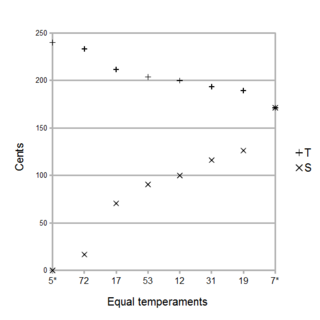Related Research Articles

An equal temperament is a musical temperament or tuning system that approximates just intervals by dividing an octave into steps such that the ratio of the frequencies of any adjacent pair of notes is the same. This system yields pitch steps perceived as equal in size, due to the logarithmic changes in pitch frequency.
Microtonal or microtonality is the use in music of microtones—intervals smaller than a semitone, also called "microintervals". It may also be extended to include any music using intervals not found in the customary Western tuning of twelve equal intervals per octave. In other words, a microtone may be thought of as a note that falls "between the keys" of a piano tuned in equal temperament.

Xenharmonic music is music that uses a tuning system that is unlike the 12-tone equal temperament scale. It was named by Ivor Darreg, from the Greek Xenos meaning both foreign and hospitable. He stated that it was "intended to include just intonation and such temperaments as the 5-, 7-, and 11-tone, along with the higher-numbered really-microtonal systems as far as one wishes to go."
A schismatic temperament is a musical tuning system that results from tempering the schisma of 32805:32768 to a unison. It is also called the schismic temperament, Helmholtz temperament, or quasi-Pythagorean temperament.
Ivor Darreg was an American composer and leading proponent of microtonal or "xenharmonic" music. He also created a series of experimental musical instruments.

A quarter tone is a pitch halfway between the usual notes of a chromatic scale or an interval about half as wide as a semitone, which itself is half a whole tone. Quarter tones divide the octave by 50 cents each, and have 24 different pitches.
TiMidity++, originally and still frequently informally called TiMidity, is a software synthesizer that can play MIDI files without a hardware synthesizer. It can either render to the sound card in real time, or it can save the result to a file, such as a PCM .wav file.
In music, 72 equal temperament, called twelfth-tone, 72-TET, 72-EDO, or 72-ET, is the tempered scale derived by dividing the octave into twelfth-tones, or in other words 72 equal steps. Each step represents a frequency ratio of 72√2, or 16+2⁄3 cents, which divides the 100 cent "halftone" into 6 equal parts and is thus a "twelfth-tone". Since 72 is divisible by 1, 2, 3, 4, 6, 8, 9, 12, 18, 24, 36, and 72, 72-EDO includes all those equal temperaments. Since it contains so many temperaments, 72-EDO contains at the same time tempered semitones, third-tones, quartertones and sixth-tones, which makes it a very versatile temperament.
Easley Rutland Blackwood Jr. was an American professor of music, concert pianist, composer, and the author of books on music theory, including his research into the properties of microtonal tunings and traditional harmony.

In music, 19 equal temperament, called 19 TET, 19 EDO, 19-ED2 or 19 ET, is the tempered scale derived by dividing the octave into 19 equal steps. Each step represents a frequency ratio of 19√2, or 63.16 cents.

Nathan Fake is an English electronic music artist from Necton, Norfolk, England. He has released music on the Border Community, Ninja Tune, and Cambria Instruments labels.
MIDI Tuning Standard (MTS) is a specification of precise musical pitch agreed to by the MIDI Manufacturers Association in the MIDI protocol. MTS allows for both a bulk tuning dump message, giving a tuning for each of 128 notes, and a tuning message for individual notes as they are played.

William Emmanuel Bevan, known by his recording alias Burial, is a British electronic musician from South London. Initially remaining anonymous, Burial became the first artist signed to Kode9's electronic label Hyperdub in 2005. He won acclaim the following year for his self-titled debut album, an influential release in the UK's dubstep scene which showcased a dark, emotive take on UK rave music styles such as UK garage and 2-step; it was named the album of the year by The Wire. Burial's second album, Untrue, was released to further critical acclaim in 2007.

Aaron Turner is an American musician, singer, graphic artist, and founder of label Hydra Head Records. He is most widely known for his role as guitarist and vocalist for the post-metal bands SUMAC and Isis, while also participating in several other bands and projects such as Old Man Gloom, Lotus Eaters and Split Cranium, a collaboration with Jussi Lehtisalo of Finnish band Circle who toured with Isis in 2009.

A regular diatonic tuning is any musical scale consisting of "tones" (T) and "semitones" (S) arranged in any rotation of the sequence TTSTTTS which adds up to the octave with all the T's being the same size and all the S's the being the same size, with the 'S's being smaller than the 'T's. In such a tuning, then the notes are connected together in a chain of seven fifths, all the same size which makes it a Linear temperament with the tempered fifth as a generator.

Paul Erlich is a guitarist and music theorist living near Boston, Massachusetts. He is known for his seminal role in developing the theory of regular temperaments, including being the first to define pajara temperament and its decatonic scales in 22-ET. He holds a Bachelor of Science degree in physics from Yale University.
Elaine Walker is a composer, electronic musician, mathematician, and author born in 1969. She wrote a physics/philosophy book, “Matter Over Mind: Cosmos, Chaos, and Curiosity” (2016). She specializes in microtonal music, including founding ZIA, an all electronic band, and performing with D.D.T. She has performed with Number Sine. She describes: "I compose microtonal music strictly by ear and leave it to others to analyze, so you won't find ratios or mathematics here."
Street Sects is an American experimental band from Austin, Texas formed in 2013, composed of vocalist Leo Ashline and multi-instrumentalist Shaun Ringsmuth. Their style is extremely abrasive, characterised by industrial rhythms, use of screamed vocals, samples of both noise and synthesizers, and nihilistic lyrics. Following two EPs released in 2014, the duo's debut album End Position was released in 2016 on The Flenser to generally positive reviews.

Venezuelan electronic music producer Arca has released ten studio albums, one remix album, two mixtapes, one compilation album, four DJ mixes, one box set, four extended plays (EPs), twenty-nine singles, twenty-three music videos, and ten remixes.
References
- 1 2 3 Johnson, Aaron. "Sevish Interview". untwelve.org. Retrieved 6 April 2020.
- ↑ "Biography - Sevish Music". sevish.com. Retrieved 6 April 2020.
- ↑ Wakabayashi, Hidekazu. "Sevish インタビュー Interview with Sevish". microtonaldiary.blog.fc2.com. Retrieved 6 April 2020.
- 1 2 3 4 5 Hart, Adam (6 September 2016). "Microtonal Tunings in Electronic Dance Music: A Survey of Precedent and Potential". Contemporary Music Review. 35 (2): 242–262. doi:10.1080/07494467.2016.1221635. S2CID 193673867.
- ↑ Tremblay, Dæv (5 May 2015). "Review: Sevish – Rhythm And Xen". Can This Even Be Called Music?. Retrieved 22 April 2020.
- ↑ Tremblay, Dæv (19 June 2017). "Sevish - Harmony Hacker". Can This Even Be Called Music?. Retrieved 22 April 2020.
- ↑ Hugill, Andrew (2018). The Digital Musician, p. 197. Routledge. ISBN 1351337386
- ↑ "Making microtonal music on Linux computers". sevish.com. 13 October 2019. Retrieved 7 June 2022.
- ↑ Tremblay, Dæv (11 July 2019). "Sevish, Glacier, Louis-Vincent Hamel, Zeitgeber, John Zorn, and Jack Quartet". Can This Even Be Called Music?. Retrieved 22 April 2020.
- ↑ "Various Artists - Crack My Pitch Up - Microtonal music at split-notes". split-notes.com. 11 July 2010. Retrieved 6 September 2021.
- ↑ "[FNet050] Various - 2MM2 : Faturenet Collective : Free Download, Borrow, and Streaming : Internet Archive". archive.org. 21 July 2013. Retrieved 17 September 2021.
- ↑ "Various Artists - Next Xen - Microtonal music at split-notes". split-notes.com. 6 February 2016. Retrieved 20 July 2021.
- ↑ "STAFFcirc vol. 7 - Terra Octava | STAFFcirc". bandcamp.com. Retrieved 23 July 2021.